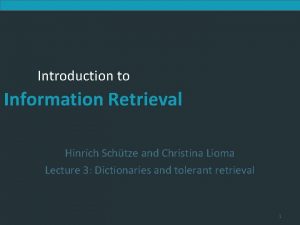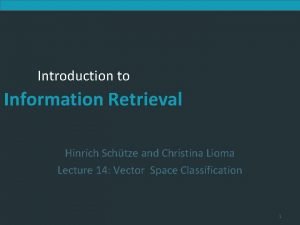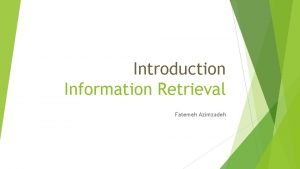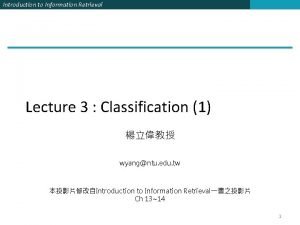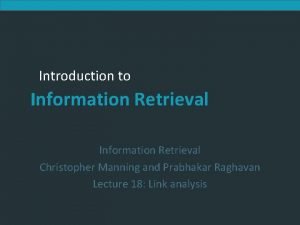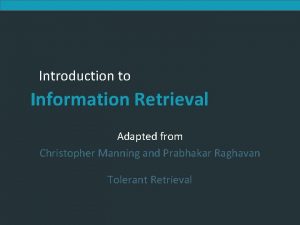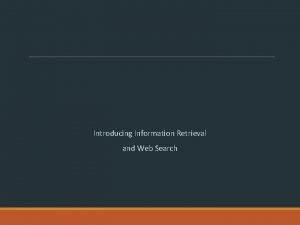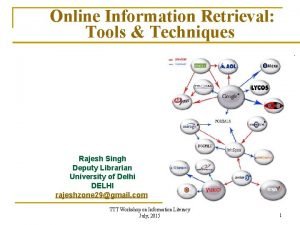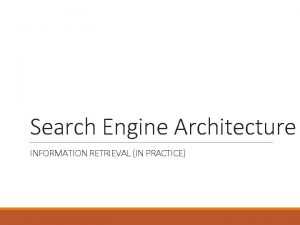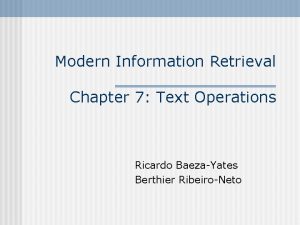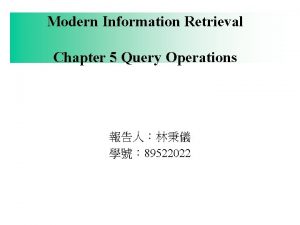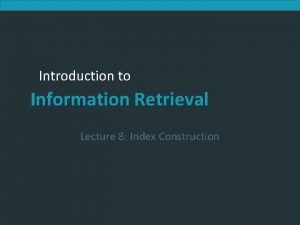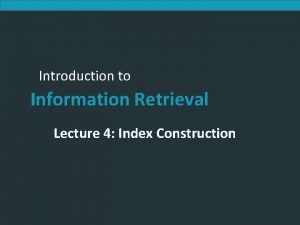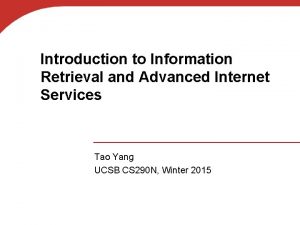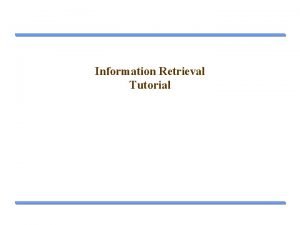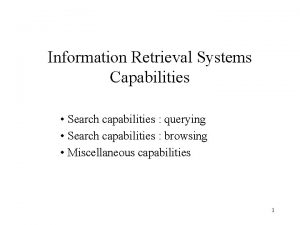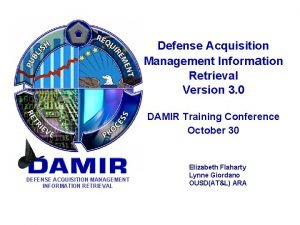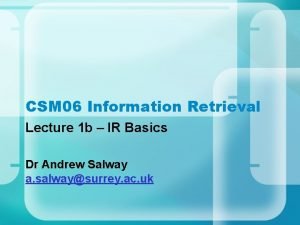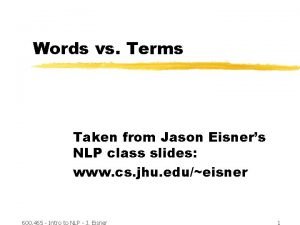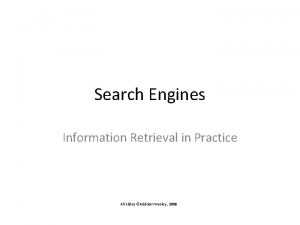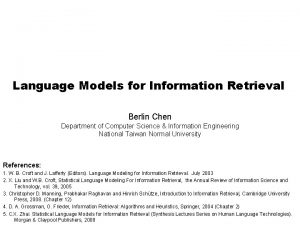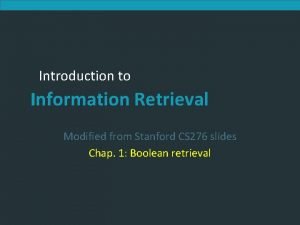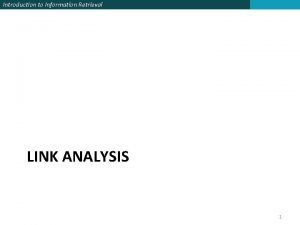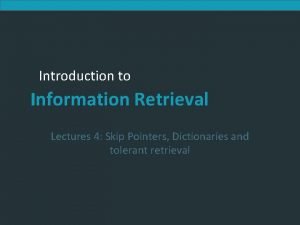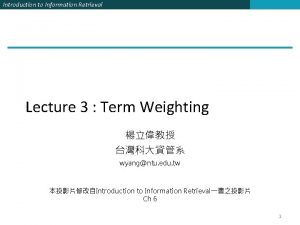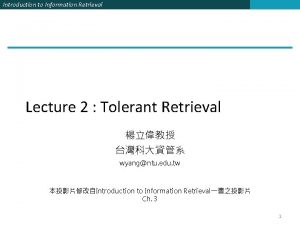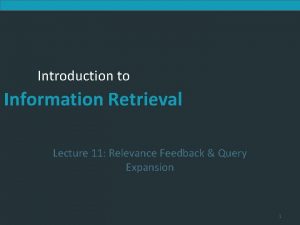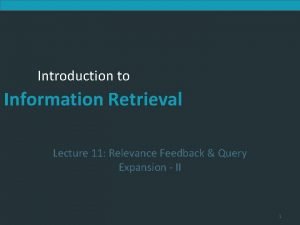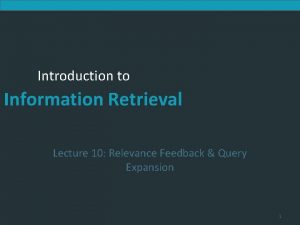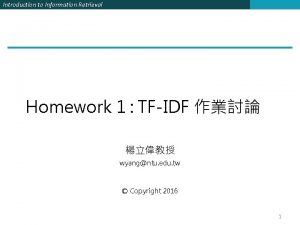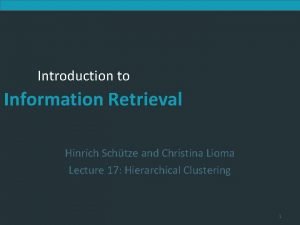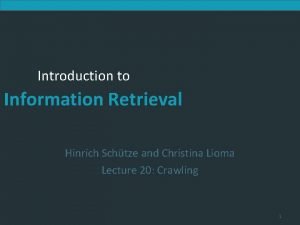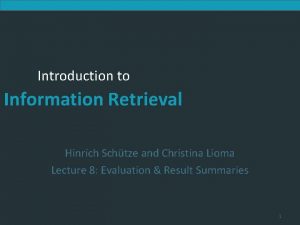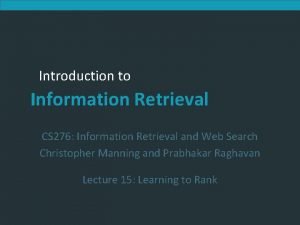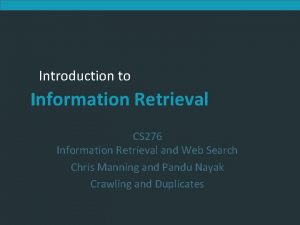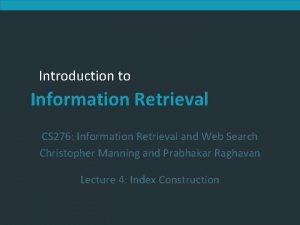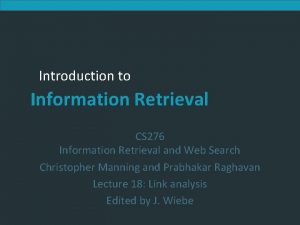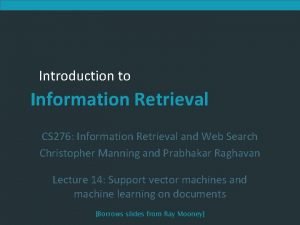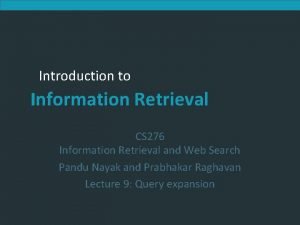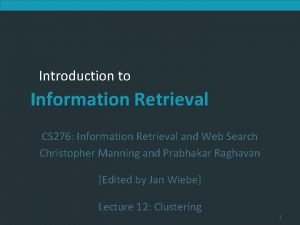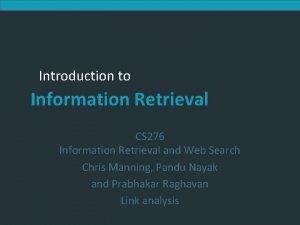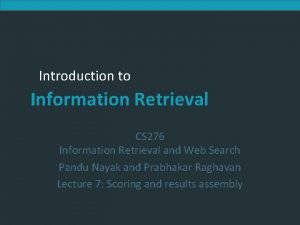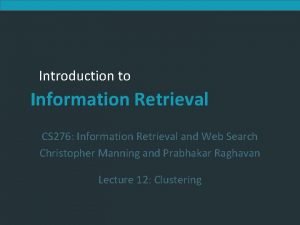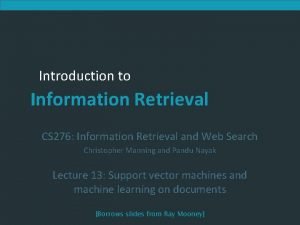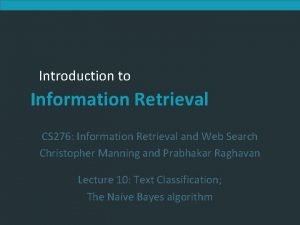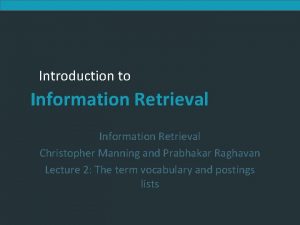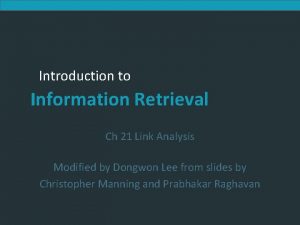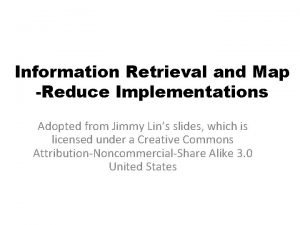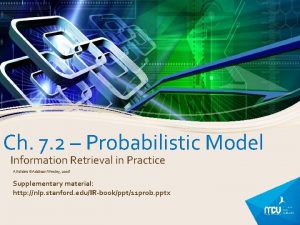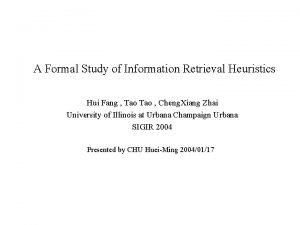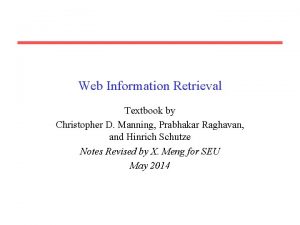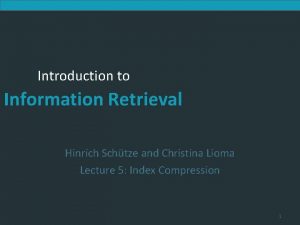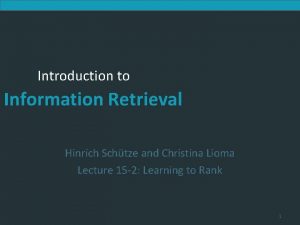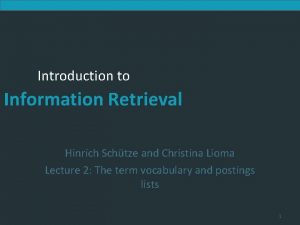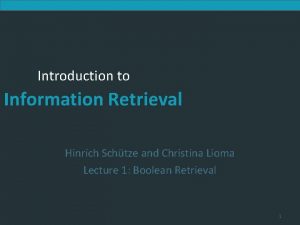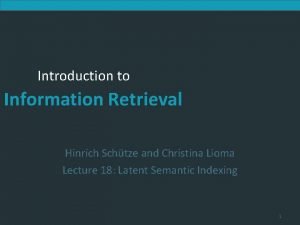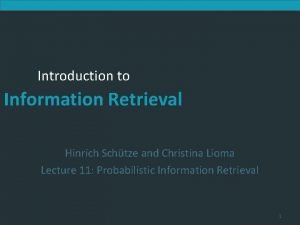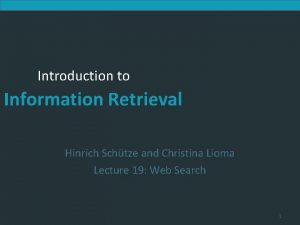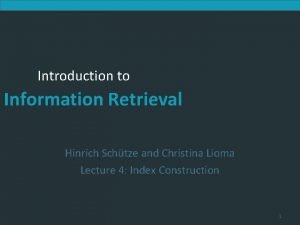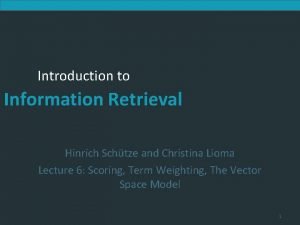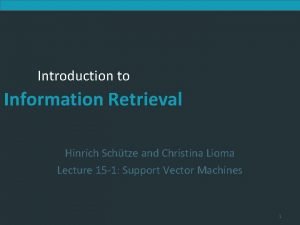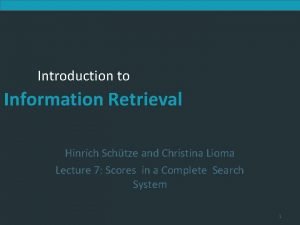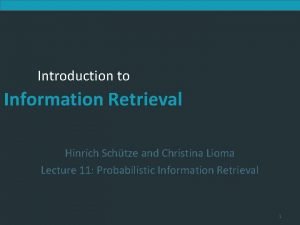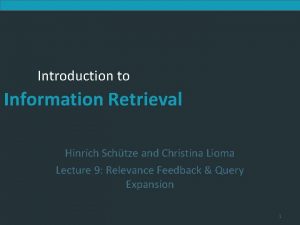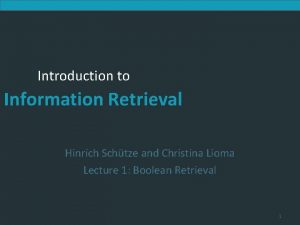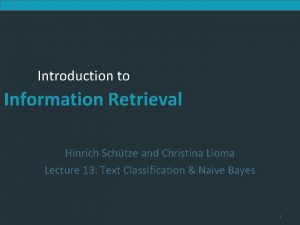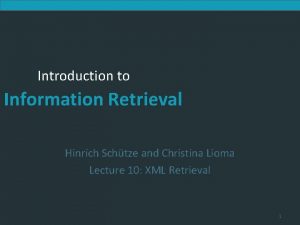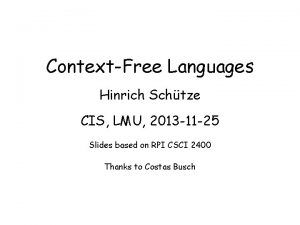Introduction to Information Retrieval Hinrich Schtze and Christina




























































- Slides: 60

Introduction to Information Retrieval Hinrich Schütze and Christina Lioma Lecture 13: Text Classification & Naive Bayes 1

Introduction to Information Retrieval Overview ❶ Recap ❷ Text classification ❸ Naive Bayes ❹ NB theory ❺ Evaluation of TC 2

Introduction to Information Retrieval Overview ❶ Recap ❷ Text classification ❸ Naive Bayes ❹ NB theory ❺ Evaluation of TC 3

Introduction to Information Retrieval Looking vs. Clicking 4

Introduction to Information Retrieval Pivot normalization Source: Lillian Lee 5

Introduction to Information Retrieval Use min heap for selecting top k out of N Use a binary min heap A binary min heap is a binary tree in which each node’s value is less than the values of its children. It takes O(N log k) operations to construct the k-heap containing the k largest values (where N is the number of documents). Essentially linear in N for small k and large N. 6

Introduction to Information Retrieval Binary min heap 7

Introduction to Information Retrieval Heuristics for finding the top k most relevant Document-at-a-time processing We complete computation of the query-document similarity score of document di before starting to compute the querydocument similarity score of di+1. Requires a consistent ordering of documents in the postings lists Term-at-a-time processing We complete processing the postings list of query term ti before starting to process the postings list of ti+1. Requires an accumulator for each document “still in the running” The most effective heuristics switch back and forth between term-at-a-time and document-at-a-time processing. 8

Introduction to Information Retrieval Tiered index 9

Introduction to Information Retrieval Complete search system 10

Introduction to Information Retrieval Take-away today Text classification: definition & relevance to information retrieval Naive Bayes: simple baseline text classifier Theory: derivation of Naive Bayes classification rule & analysis Evaluation of text classification: how do we know it worked / didn’t work? 11

Introduction to Information Retrieval Outline ❶ Recap ❷ Text classification ❸ Naive Bayes ❹ NB theory ❺ Evaluation of TC 12

Introduction to Information Retrieval A text classification task: Email spam filtering From: ‘‘’’ <takworlld@hotmail. com> Subject: real estate is the only way. . . gem oalvgkay Anyone can buy real estate with no money down Stop paying rent TODAY ! There is no need to spend hundreds or even thousands for similar courses I am 22 years old and I have already purchased 6 properties using the methods outlined in this truly INCREDIBLE ebook. Change your life NOW ! ========================= Click Below to order: http: //www. wholesaledaily. com/sales/nmd. htm ========================= How would you write a program that would automatically detect and delete this type of message? 13

Introduction to Information Retrieval Formal definition of TC: Training Given: A document space X Documents are represented in this space – typically some type of high-dimensional space. A fixed set of classes C = {c 1, c 2, . . . , c. J} The classes are human-defined for the needs of an application (e. g. , relevant vs. nonrelevant). A training set D of labeled documents with each labeled document <d, c> ∈ X × C Using a learning method or learning algorithm, we then wish to learn a classifier ϒ that maps documents to classes: ϒ: X→C 14

Introduction to Information Retrieval Formal definition of TC: Application/Testing C, Given: a description d ∈ X of a document Determine: ϒ (d) ∈ that is, the class that is most appropriate for d 15

Introduction to Information Retrieval Topic classification 16

Introduction to Information Retrieval Exercise Find examples of uses of text classification in information retrieval 17

Introduction to Information Retrieval Examples of how search engines use classification Language identification (classes: English vs. French etc. ) The automatic detection of spam pages (spam vs. nonspam) The automatic detection of sexually explicit content (sexually explicit vs. not) Topic-specific or vertical search – restrict search to a “vertical” like “related to health” (relevant to vertical vs. not) Standing queries (e. g. , Google Alerts) Sentiment detection: is a movie or product review positive or negative (positive vs. negative) 18

Introduction to Information Retrieval Classification methods: 1. Manual classification was used by Yahoo in the beginning of the web. Also: ODP, Pub. Med Very accurate if job is done by experts Consistent when the problem size and team is small Scaling manual classification is difficult and expensive. → We need automatic methods for classification. 19

Introduction to Information Retrieval Classification methods: 2. Rule-based Our Google Alerts example was rule-based classification. There are IDE-type development enviroments for writing very complex rules efficiently. (e. g. , Verity) Often: Boolean combinations (as in Google Alerts) Accuracy is very high if a rule has been carefully refined over time by a subject expert. Building and maintaining rule-based classification systems is cumbersome and expensive. 20

Introduction to Information Retrieval A Verity topic (a complex classification rule) 21

Introduction to Information Retrieval Classification methods: 3. Statistical/Probabilistic This was our definition of the classification problem – text classification as a learning problem (i) Supervised learning of a the classification function ϒ and (ii) its application to classifying new documents We will look at a couple of methods for doing this: Naive Bayes, Rocchio, k. NN, SVMs No free lunch: requires hand-classified training data But this manual classification can be done by non-experts. 22

Introduction to Information Retrieval Outline ❶ Recap ❷ Text classification ❸ Naive Bayes ❹ NB theory ❺ Evaluation of TC 23

Introduction to Information Retrieval The Naive Bayes classifier is a probabilistic classifier. We compute the probability of a document d being in a class c as follows: nd is the length of the document. (number of tokens) P(tk |c) is the conditional probability of term tk occurring in a document of class c P(tk |c) as a measure of how much evidence tk contributes that c is the correct class. P(c) is the prior probability of c. If a document’s terms do not provide clear evidence for one class vs. another, we choose the c with highest P(c). 24

Introduction to Information Retrieval Maximum a posteriori class Our goal in Naive Bayes classification is to find the “best” class. The best class is the most likely or maximum a posteriori (MAP) class cmap: 25

Introduction to Information Retrieval Taking the log Multiplying lots of small probabilities can result in floating point underflow. Since log(xy) = log(x) + log(y), we can sum log probabilities instead of multiplying probabilities. Since log is a monotonic function, the class with the highest score does not change. So what we usually compute in practice is: 26

Introduction to Information Retrieval Naive Bayes classifier Classification rule: Simple interpretation: Each conditional parameter log is a weight that indicates how good an indicator tk is for c. The prior log is a weight that indicates the relative frequency of c. The sum of log prior and term weights is then a measure of how much evidence there is for the document being in the class. We select the class with the most evidence. 27

Introduction to Information Retrieval Parameter estimation take 1: Maximum likelihood Estimate parameters Prior: and from train data: How? Nc : number of docs in class c; N: total number of docs Conditional probabilities: Tct is the number of tokens of t in training documents from class c (includes multiple occurrences) We’ve made a Naive Bayes independence assumption here: 28

Introduction to Information Retrieval The problem with maximum likelihood estimates: Zeros P(China|d) ∝ P(China) ・ P(BEIJING|China) ・ P(AND|China) ・ P(TAIPEI|China) ・ P(JOIN|China) ・ P(WTO|China) If WTO never occurs in class China in the train set: 29

Introduction to Information Retrieval The problem with maximum likelihood estimates: Zeros (cont) If there were no occurrences of WTO in documents in class China, we’d get a zero estimate: → We will get P(China|d) = 0 for any document that contains WTO! Zero probabilities cannot be conditioned away. 30

Introduction to Information Retrieval To avoid zeros: Add-one smoothing Before: Now: Add one to each count to avoid zeros: B is the number of different words (in this case the size of the vocabulary: |V | = M) 31

Introduction to Information Retrieval To avoid zeros: Add-one smoothing Estimate parameters from the training corpus using add-one smoothing For a new document, for each class, compute sum of (i) log of prior and (ii) logs of conditional probabilities of the terms Assign the document to the class with the largest score 32

Introduction to Information Retrieval Naive Bayes: Training 33

Introduction to Information Retrieval Naive Bayes: Testing 34

Introduction to Information Retrieval Exercise Estimate parameters of Naive Bayes classifier Classify test document 35

Introduction to Information Retrieval Example: Parameter estimates The denominators are (8 + 6) and (3 + 6) because the lengths of textc and are 8 and 3, respectively, and because the constant B is 6 as the vocabulary consists of six terms. 36

Introduction to Information Retrieval Example: Classification Thus, the classifier assigns the test document to c = China. The reason for this classification decision is that the three occurrences of the positive indicator CHINESE in d 5 outweigh the occurrences of the two negative indicators JAPAN and TOKYO. 37

Introduction to Information Retrieval Time complexity of Naive Bayes Lave: average length of a training doc, La: length of the test doc, Ma: number of distinct terms in the test doc, training set, V : vocabulary, set of classes is the time it takes to compute all counts. is the time it takes to compute the parameters from the counts. Generally: Test time is also linear (in the length of the test document). Thus: Naive Bayes is linear in the size of the training set (training) and the test document (testing). This is optimal. 38

Introduction to Information Retrieval Outline ❶ Recap ❷ Text classification ❸ Naive Bayes ❹ NB theory ❺ Evaluation of TC 39

Introduction to Information Retrieval Naive Bayes: Analysis Now we want to gain a better understanding of the properties of Naive Bayes. We will formally derive the classification rule. . . . and state the assumptions we make in that derivation explicitly. 40

Introduction to Information Retrieval Derivation of Naive Bayes rule We want to find the class that is most likely given the document: Apply Bayes rule Drop denominator since P(d) is the same for all classes: 41

Introduction to Information Retrieval Too many parameters / sparseness There are too many parameters , one for each unique combination of a class and a sequence of words. We would need a very, very large number of training examples to estimate that many parameters. This is the problem of data sparseness. 42

Introduction to Information Retrieval Naive Bayes conditional independence assumption To reduce the number of parameters to a manageable size, we make the Naive Bayes conditional independence assumption: We assume that the probability of observing the conjunction of attributes is equal to the product of the individual probabilities P(Xk = tk |c). Recall from earlier the estimates for these priors and conditional probabilities: 43

Introduction to Information Retrieval Generative model Generate a class with probability P(c) Generate each of the words (in their respective positions), conditional on the class, but independent of each other, with probability P(tk |c) To classify docs, we “reengineer” this process and find the class that is most likely to have generated the doc. 44

Introduction to Information Retrieval Second independence assumption For example, for a document in the class UK, the probability of generating QUEEN in the first position of the document is the same as generating it in the last position. The two independence assumptions amount to the bag of words model. 45

Introduction to Information Retrieval A different Naive Bayes model: Bernoulli model 46

Introduction to Information Retrieval Violation of Naive Bayes independence assumption The independence assumptions do not really hold of documents written in natural language. Conditional independence: Positional independence: Exercise Examples for why conditional independence assumption is not really true? Examples for why positional independence assumption is not really true? How can Naive Bayes work if it makes such inappropriate assumptions? 47

Introduction to Information Retrieval Why does Naive Bayes work? Naive Bayes can work well even though conditional independence assumptions are badly violated. Example: Double counting of evidence causes underestimation (0. 01) and overestimation (0. 99). Classification is about predicting the correct class and not about accurately estimating probabilities. Correct estimation ⇒ accurate prediction. But not vice versa! 48

Introduction to Information Retrieval Naive Bayes is not so naive Naive Bayes has won some bakeoffs (e. g. , KDD-CUP 97) More robust to nonrelevant features than some more complex learning methods More robust to concept drift (changing of definition of class over time) than some more complex learning methods Better than methods like decision trees when we have many equally important features A good dependable baseline for text classification (but not the best) Optimal if independence assumptions hold (never true for text, but true for some domains) Very fast Low storage requirements 49

Introduction to Information Retrieval Outline ❶ Recap ❷ Text classification ❸ Naive Bayes ❹ NB theory ❺ Evaluation of TC 50

Introduction to Information Retrieval Evaluation on Reuters 51

Introduction to Information Retrieval Example: The Reuters collection 52

Introduction to Information Retrieval A Reuters document 53

Introduction to Information Retrieval Evaluating classification Evaluation must be done on test data that are independent of the training data (usually a disjoint set of instances). It’s easy to get good performance on a test set that was available to the learner during training (e. g. , just memorize the test set). Measures: Precision, recall, F 1, classification accuracy 54

Introduction to Information Retrieval Precision P and recall R P = TP / ( TP + FP) R = TP / ( TP + FN) 55

Introduction to Information Retrieval A combined measure: F F 1 allows us to trade off precision against recall. This is the harmonic mean of P and R: 56

Introduction to Information Retrieval Averaging: Micro vs. Macro We now have an evaluation measure (F 1) for one class. But we also want a single number that measures the aggregate performance over all classes in the collection. Macroaveraging Compute F 1 for each of the C classes Average these C numbers Microaveraging Compute TP, FN for each of the C classes Sum these C numbers (e. g. , all TP to get aggregate TP) Compute F 1 for aggregate TP, FN 57

Introduction to Information Retrieval Naive Bayes vs. other methods 58

Introduction to Information Retrieval Take-away today Text classification: definition & relevance to information retrieval Naive Bayes: simple baseline text classifier Theory: derivation of Naive Bayes classification rule & analysis Evaluation of text classification: how do we know it worked / didn’t work? 59

Introduction to Information Retrieval Resources Chapter 13 of IIR Resources at http: //ifnlp. org/ir Weka: A data mining software package that includes an implementation of Naive Bayes Reuters-21578 – the most famous text classification evaluation set (but now it’s too small for realistic experiments) 60
 Hinrich slobbe
Hinrich slobbe Document correction
Document correction Christina computes
Christina computes Manning introduction to information retrieval
Manning introduction to information retrieval Concept drift example
Concept drift example Introduction to information retrieval
Introduction to information retrieval Introduction to information retrieval manning
Introduction to information retrieval manning Information retrieval evaluation
Information retrieval evaluation Information retrieval and web search
Information retrieval and web search Information retrieval data structures and algorithms
Information retrieval data structures and algorithms Examples of information retrieval tools
Examples of information retrieval tools Information retrieval data structures and algorithms
Information retrieval data structures and algorithms Sequential search algorithm
Sequential search algorithm Search engine architecture
Search engine architecture Modern information retrieval
Modern information retrieval Query operations in information retrieval
Query operations in information retrieval For skip pointer more skip leads to
For skip pointer more skip leads to Index construction in information retrieval
Index construction in information retrieval Bsbi vs spimi
Bsbi vs spimi Which internet service is used for information retrieval
Which internet service is used for information retrieval Information retrieval tutorial
Information retrieval tutorial Wild card queries in information retrieval
Wild card queries in information retrieval Search capabilities in irs
Search capabilities in irs Link analysis in information retrieval
Link analysis in information retrieval Information retrieval lmu
Information retrieval lmu Defense acquisition management information retrieval
Defense acquisition management information retrieval Advantages of information retrieval system
Advantages of information retrieval system Information retrieval nlp
Information retrieval nlp Information retrieval slides
Information retrieval slides Relevance information retrieval
Relevance information retrieval Stanford information retrieval
Stanford information retrieval Link analysis in information retrieval
Link analysis in information retrieval Skip pointer
Skip pointer Information retrieval
Information retrieval Levenshtein distance for oslo-snow
Levenshtein distance for oslo-snow Information retrieval
Information retrieval Information retrieval
Information retrieval Relevance information retrieval
Relevance information retrieval Information retrieval
Information retrieval Information retrieval
Information retrieval Information retrieval
Information retrieval Information retrieval
Information retrieval Cs 276
Cs 276 Introduction
Introduction Information retrieval
Information retrieval Information retrieval
Information retrieval Information retrieval
Information retrieval Relevance information retrieval
Relevance information retrieval Information retrieval
Information retrieval Information retrieval
Information retrieval Information retrieval
Information retrieval Information retrieval
Information retrieval Information retrieval
Information retrieval Information retrieval
Information retrieval Tokenization in information retrieval
Tokenization in information retrieval Link analysis in information retrieval
Link analysis in information retrieval Map information retrieval
Map information retrieval Probabilistic model information retrieval
Probabilistic model information retrieval A formal study of information retrieval heuristics
A formal study of information retrieval heuristics Relevance information retrieval
Relevance information retrieval Information retrieval textbook
Information retrieval textbook

